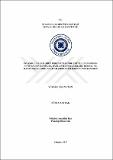Please use this identifier to cite or link to this item:
http://hdl.handle.net/11547/1587Full metadata record
| DC Field | Value | Language |
|---|---|---|
| dc.contributor.author | Bayrak, Büşra | - |
| dc.date.accessioned | 2019-04-28T12:03:32Z | - |
| dc.date.available | 2019-04-28T12:03:32Z | - |
| dc.date.issued | 2017-08 | - |
| dc.identifier.uri | http://hdl.handle.net/11547/1587 | - |
| dc.description.abstract | Nomofobi, bireylerin cep telefonlarıyla temaslarını kaybettiklerinde ortaya çıkan yoğun duygusal sıkıntı olarak tanımlanmaktadır. Bu çalışmanın amacı bağlanma özellikleri, ruhsal ve davranışsal sorunlar ve nomofobi arasındaki ilişkiyi araştırmaktır. Çalışma İstanbul'daki üç liseden gönüllü 819 ergen (%46 erkek, n = 379; % 54 kadın n = 440) ile yürütülmüştür. Katılımcılara uygulanan anketler, Nomofobi Anketi (NMP-Q), Güçler ve Güçlükler Anketi (GGA) ve Ebeveyn ve Arkadaşlara Bağlanma Envanteridir (EABE). Ergenler, NMP-Q puanlarına göre, nomofobinin hafif, orta ve ciddi derecesine göre gruplandırılmıştır. EABE ve GGA puanları tek yönlü varyans analizi (ANOVA) ile karşılaştırılmıştır. Kategorik değişkenler ki-kare testi ile karşılaştırılmıştır. Ölçekler arası ilişkiyi belirlemek için Pearson Momentler Çarpımı Korelayon Analizi yapılmıştır. Bağlanma puanlarının ve ruhsal ve davranışsal sorunların NMP-Q düzeylerinde öngörülebilirliği çok değişkenli doğrusal regresyon analizi ile test edilmiştir. Katılımcıların % 34.3'ü (n = 281) hafif, % 55.4'ü (n = 453) orta, % 10.4'ü (n = 85) ciddi nomofobi derecesinde çıkmıştır. Anne ve babanın bağlanma puanları anlamlı derecede düşük, yabancılaşma puanları ciddi nomofobi grubunda orta ve hafif derecede nomofobi grubuna göre anlamlı derecede yüksektir (p <0.05). Ergenlerin GGA toplam sorun puanları, davranış sorunları, duygusal sorunları, dikkat eksikliği ve hiperaktivite alt ölçeği puanları ciddi nomofobi grubunda orta ve hafif derecedeki nomofobi gruplarına göre anlamlı derecede yüksek çıkmıştır (p <0.05). Korelasyon analizine göre, toplam NMP-Q skorlarının, ergenlerin GGA toplam sorun puanlarıyla (r = 225) pozitif korelasyon gösterdiği ve anne bağlanma toplam (r = -121) ve baba bağlanma toplam (r = -122) puanları ile negatif korelasyon gösterdiği ortaya çıkmıştır, EBAE (p <.0.01). Çoklu doğrusal regresyon analizinde ise, tüm alt ölçekler analiz edilmiş ve EABE’nin anne ve baba bağlanma toplam puanları, baba iletişim puanı (p <0.05) ve anne yabancılaşma puanı (p <0.05), nomofobi puanlarını önemli ölçüde etkilemektedir. GGA ergen toplam sorun puanı (p <0.05) ise nomofobi puanlarını önemli ölçüde etkilemede anlamlılığa yaklaşmıştır. Bu çalışmanın sonuçlarına göre, hem akademik hem de klinik alanda nomofobisi olan ergenleri değerlendirirken bağlanma özelliklerine, ruhsal ve davranışsal sorunlara odaklanmanın önemli olacağı düşünülmektedir. | tr_TR |
| dc.language.iso | tr | tr_TR |
| dc.publisher | İSTANBUL AYDIN ÜNİVERSİTESİ SOSYAL BİLİMLER ENSTİTÜSÜ | tr_TR |
| dc.subject | Bağlanma | tr_TR |
| dc.subject | Cep telefonundan ayrı kalma korkusu(Nomofobi) | tr_TR |
| dc.subject | Ruhsal ve Davranışsal Sorunlar | tr_TR |
| dc.subject | Ergenlik | tr_TR |
| dc.subject | Attachment | tr_TR |
| dc.subject | Nomophobia | tr_TR |
| dc.subject | Mental and Behavioral Disorders | tr_TR |
| dc.subject | Puberty | tr_TR |
| dc.title | İSTANBUL’DA BİR GRUP ERGEN ÜZERİNDE CEP TELEFONUNDAN AYRI KALMA KORKUSU, BAĞLANMA ÖZELLİKLERİ, RUHSAL VE DAVRANIŞSAL SORUNLAR ARASINDAKİ İLİŞKİNİN İNCELENMESİ | tr_TR |
| dc.type | Thesis | tr_TR |
| dc.description.abstractol | Nomophobia is defined as an intense emotional distress emerging when the individuals lose contact with their mobile phones. The aim of this study is to investigate the relationship between the attachment characteristics, mental problems, and the nomophobia. Method: The participants were 819 adolescents (46 % male, n=379 ; 54 % female n=440) collected from five high schools in Istanbul, Turkey. The instruments completed by the participants was the Nomophobia Questionnaire (NMP-Q), Strengths and Difficulties Questionnaire (SDQ), and a Short Form of Inventory of Parent and Peer Attachment (s-IPPA). The adolescents were grouped as to their reactions categorised as mild, moderate and severe reactions of nomophobia according to their NMP-Q scores. The scores of the s-IPPA and SDQ were compared with one way variance analysis (ANOVA). The categorical variables were compared with chi square test. The correlations between the scale scores were analyzed with Pearson-product moment correlation test. The predictability of the attachment scores and mental and behavioural problems on the NMP-Q levels were tested with multivariate linear regression analysis. 34.3 % of the participants (n= 281) had mild, 55.4 % (n= 453) had moderate, and 10.4 % (n= 85) had severe nomophobia. Maternal and paternal attachment scores were significantly lower, and alienation scores were significantly higher in the severe nomophobia group compared to the moderate and mild nomophonia groups (p<0.05). Total problem scores, conduct, emotional symptoms, inattention/hyperactivity subscale scores of the self-report SDQ were significantly higher in severe nomohobia group compared to the moderate and mild nomophonia groups (p<0.05). The correlation analysis indicated that total NMP-Q scores positively correlated with the total problem scores of self-report SDQ (r=225) and negatively correlated with the total maternal (r=-121) and paternal attachment (r=-122) scores of the s-IPPA (p<.0.01). Linear regression analysis indicated that maternal and paternal attachment scores, parental communication scores (p<0.05), maternal alienation scores (p<0.05) of the s-IPPA, total problem scores of the self-report SDQ (p<0.05) significantly predict the nomophobia scores. The results of this study suggest it is significant to focus on attachment characteristics, and mental and behavioural problems when evaluating the adolescents with nomophobia in both the academic or clinical field. | tr_TR |
| dc.publisher.firstpagenumber | 1 | tr_TR |
| dc.publisher.lastpagenumber | 68 | tr_TR |
| Appears in Collections: | Tezler -- Thesis | |
Files in This Item:
| File | Description | Size | Format | |
|---|---|---|---|---|
| İSTANBUL’DA BİR GRUP ERGEN ÜZERİNDE CEP TELEFONUNDAN AYRI KALMA KORKUSU, BAĞLANMA ÖZELLİKLERİ, RUHSAL VE DAVRANIŞSAL SORUNLAR ARASINDAKİ İLİŞKİNİN İNCELENMESİ.pdf | Tez Dosyası | 2.9 MB | Adobe PDF |  View/Open |
Items in DSpace are protected by copyright, with all rights reserved, unless otherwise indicated.
